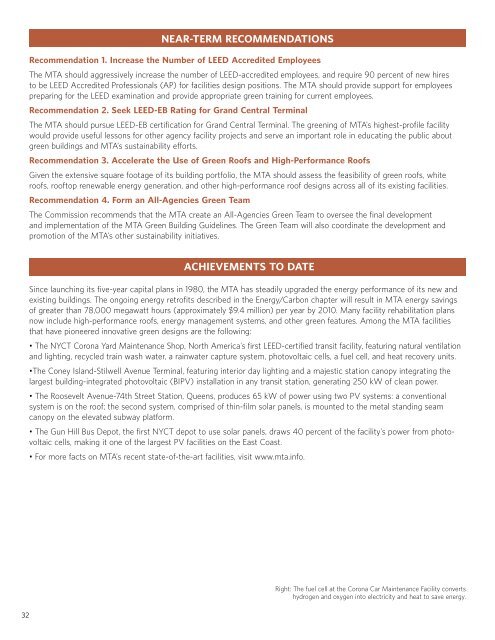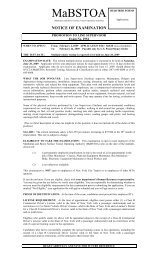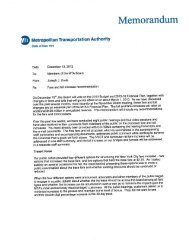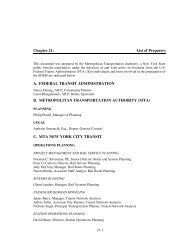Greening Mass Transit & Metro Regions: The Final Report - MTA
Greening Mass Transit & Metro Regions: The Final Report - MTA
Greening Mass Transit & Metro Regions: The Final Report - MTA
Create successful ePaper yourself
Turn your PDF publications into a flip-book with our unique Google optimized e-Paper software.
32<br />
NEAR-TERM RECOMMENDATIONS<br />
Recommendation 1. Increase the Number of LEED Accredited Employees<br />
<strong>The</strong> <strong>MTA</strong> should aggressively increase the number of LEED-accredited employees, and require 90 percent of new hires<br />
to be LEED Accredited Professionals (AP) for facilities design positions. <strong>The</strong> <strong>MTA</strong> should provide support for employees<br />
preparing for the LEED examination and provide appropriate green training for current employees.<br />
Recommendation 2. Seek LEED-EB Rating for Grand Central Terminal<br />
<strong>The</strong> <strong>MTA</strong> should pursue LEED-EB certification for Grand Central Terminal. <strong>The</strong> greening of <strong>MTA</strong>’s highest-profile facility<br />
would provide useful lessons for other agency facility projects and serve an important role in educating the public about<br />
green buildings and <strong>MTA</strong>’s sustainability efforts.<br />
Recommendation 3. Accelerate the Use of Green Roofs and High-Performance Roofs<br />
Given the extensive square footage of its building portfolio, the <strong>MTA</strong> should assess the feasibility of green roofs, white<br />
roofs, rooftop renewable energy generation, and other high-performance roof designs across all of its existing facilities.<br />
Recommendation 4. Form an All-Agencies Green Team<br />
<strong>The</strong> Commission recommends that the <strong>MTA</strong> create an All-Agencies Green Team to oversee the final development<br />
and implementation of the <strong>MTA</strong> Green Building Guidelines. <strong>The</strong> Green Team will also coordinate the development and<br />
promotion of the <strong>MTA</strong>’s other sustainability initiatives.<br />
ACHIEVEMENTS TO DATE<br />
Since launching its five-year capital plans in 1980, the <strong>MTA</strong> has steadily upgraded the energy performance of its new and<br />
existing buildings. <strong>The</strong> ongoing energy retrofits described in the Energy/Carbon chapter will result in <strong>MTA</strong> energy savings<br />
of greater than 78,000 megawatt hours (approximately $9.4 million) per year by 2010. Many facility rehabilitation plans<br />
now include high-performance roofs, energy management systems, and other green features. Among the <strong>MTA</strong> facilities<br />
that have pioneered innovative green designs are the following:<br />
• <strong>The</strong> NYCT Corona Yard Maintenance Shop, North America’s first LEED-certified transit facility, featuring natural ventilation<br />
and lighting, recycled train wash water, a rainwater capture system, photovoltaic cells, a fuel cell, and heat recovery units.<br />
•<strong>The</strong> Coney Island-Stilwell Avenue Terminal, featuring interior day lighting and a majestic station canopy integrating the<br />
largest building-integrated photovoltaic (BIPV) installation in any transit station, generating 250 kW of clean power.<br />
• <strong>The</strong> Roosevelt Avenue-74th Street Station, Queens, produces 65 kW of power using two PV systems: a conventional<br />
system is on the roof; the second system, comprised of thin-film solar panels, is mounted to the metal standing seam<br />
canopy on the elevated subway platform.<br />
• <strong>The</strong> Gun Hill Bus Depot, the first NYCT depot to use solar panels, draws 40 percent of the facility’s power from photovoltaic<br />
cells, making it one of the largest PV facilities on the East Coast.<br />
• For more facts on <strong>MTA</strong>’s recent state-of-the-art facilities, visit www.mta.info.<br />
Right: <strong>The</strong> fuel cell at the Corona Car Maintenance Facility converts<br />
hydrogen and oxygen into electricity and heat to save energy.
















